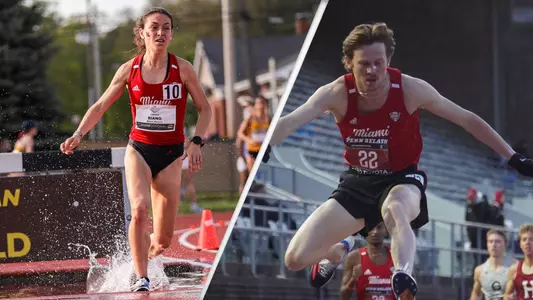
Carmen Riano (left) and Charlie Harders (right) are among seven Miami athletes competing at this week's NCAA East Prelims
The Thrill of the Chase
5/26/2022 10:54:00 AM | Track & Field, Cross Country
Once upon a time in Oxford, a unique competition began.
Many stories on MiamiRedHawks.com could start that way. But in this instance, we're not talking about Oxford, Ohio.
The event in question took place nearly 4,000 miles east in Oxford, England.
"Back in the day in England they used to have point-to-point races," said Tom Chorny, Miami director of track and field/cross country. "They would have a starting line, and then way off in the distance you could typically see the steeple of a church. It was up to you to figure out how you got there. So you would jump over ditches and fences and get there as fast as you could."
What used to be streams and rivers turned into water barriers. The walls scattered around the countryside were replaced with hurdles. And before long, track's 3000m steeplechase race was born. World Athletics says the initial concept was developed at Oxford University, and the competition was first included in the English Championships in 1879.
It's a unique race and requires a special type of competitor. Chorny should know. He won the U.S. national championship in 2001, going on to represent the USA at the world championships that year in Edmonton. And in his time at Miami University, he has helped develop a impressive group of 'steeplers', including current standouts Charlie Harders, a senior from Western Springs, Ill, and Carmen Riano, a sophomore from Peralta, Spain.
Harders and Riano swept the men's and women's steeplechase at this month's MAC Outdoor Track and Field Championships, becoming the first Miami runners to do so in nearly 30 years. This weekend, they will compete in the NCAA East Preliminary in Bloomington, Ind. as part of a group of seven RedHawk athletes trying to qualify for the national meet in various events and races.
The pair of accomplished steeplers are good at running long distances. They're good at hurdling.
And perhaps, most importantly…they're willing to get wet.
- - -
"I wear socks for every race except steeple," Harders said with a laugh.
"When it's warm outside, it's nice. When you're running, your feet get really hot, and when you touch the water, it's amazing," said Riano. "But when it's cold? It's not that fun."
For those who may be unfamiliar with the steeplechase, the 3,000-meter race is not only seven and a half laps on the track, but it also includes 35 barriers: five in each full lap. The men's barriers are 36 inches high, while the women's barriers are 30 inches tall. Four of the five in each lap are 'normal' barriers, but the fifth is a 'water jump' that leads to a 12-foot by 12-foot inclined pit of water, which is more than two feet deep at its deepest point.
The heavy-duty barriers are solid and don't tip over easily like a sprinter's hurdle. Competitors clear the usual barriers without touching them, but most push off the water barrier with their feet, trying to get through as much of the pool as possible so their pace doesn't slow.
"You normally have one foot in the water and ideally your next step will be dry," said Harders. "There's a little bit of splash…in a big race, though, you can come out pretty soaked, because there's a lot of people around you splashing."
It's not an easy thing to practice, especially because filling the water pit at the track can take more than two hours! But with all the potential slipping and sloshing, how a competitor handles the water jump each time around the track can make or break their race.
"There are a lot of falls at the water barrier, because when you're tired, you can land incorrectly or maybe not jump far enough. That seems to be the most common place for errors," Harders said. "It's such a taxing event where people can really become totally spent that last lap and not have the energy to jump with good form."
Riano agreed. "The better you get out of the water, the faster you run," she said. "The jumps make the race way harder, and the water jump even more because it takes more out of you than the normal jumps.
"But at the same time, it's something that makes the race different, and makes it more enjoyable."
- - -
Ask Chorny what makes a good steeplechaser, and the response is short and sweet: "Grit and determination."
The Miami coaches begin working with their runners immediately after cross country season ends in the fall to get them ready for the unique rigors of the sport's only distance race that involves hurdling. The RedHawks' steeplers will practice jumping literally thousands of times before their first spring competition, and the learning curve is especially steep for many young runners who haven't really been exposed to the event before college (since most states' high school track meets do not feature the steeplechase).
"It really helps, because that slowly builds that stamina of continuous jumping," Harders said. "It's a totally different fatigue…I think you have to race it once to really feel the pain." He compared it to playing a full-court basketball game where the jumping for layups and rebounds is constant, but an athlete is also running up and down the whole time with no breaks (or television timeouts!).
"The race is so taxing and painful, but the tactics at play are really something else," Harders continued. "I have more fun steepling than I do in any other race…The people who are very good at steeple are some of the grittiest and toughest competitors because it is such a hard race. That's why I love it: Going up against those guys makes winning and running fast times even more rewarding.
"You feel like you're up against the toughest guys in the NCAA."
- - -
This weekend's NCAA East Prelims will be held on the campus of Indiana University. It's a familiar venue for the RedHawks that will be competing, as the 2021-22 Miami track/cross country schedule included four different events in Bloomington (Indiana Opener, Hoosier Open, Indiana Relays, and Indiana Invitational).
It's also a blast from the past for several of the Miami coaches. Chorny was a three-time All-American at IU, and he served as a volunteer coach for the Hoosiers from 2007-2013 helping train steeplechasers, including De'Sean Turner. Turner, one of Indiana's 11 All-Americans in the event during that time period, qualified for the U.S. world championships team in 2013, and now serves as an assistant coach on Chorny's staff at Miami.
Chorny and Turner's expertise in the steeple has helped make it one of the strongest events for the Miami track and field program, and Chorny said he's hoping the RedHawks will be known for the kind of long-term pipeline of national and even international success that he experienced firsthand in Bloomington.
"Even when I was at Indiana, where De'Sean was one of the athletes, we were pretty serious about our steeple-specific training, and they were some of the best hurdlers out there," Chorny said. "That's always what makes you good. You have to be a good athlete to start off, but then once you become a really good hurdler and your efficiency gets really good, that allows you to become one of the best in the NCAA."
Riano said she was impressed when she arrived on campus from Spain at how many different drills, workouts and exercises the RedHawks used to develop their steepling ability.
"When you don't know how to jump, or you think you're jumping fine, then sometimes Chorny or De'Sean just jump over the barrier to show you how you should do it, and it's insane," she said. "You can learn so much from that.
"They have experienced every single thing, running for that many years. When you feel bad, when you feel tired, when you feel amazing: They can just tell you what to do."
Harders said having steeple-oriented coaches was one of the main reasons why he chose to come to Miami. "As coaches who have had full careers in steeple, they know a lot of the tactics: Which laps are going to hurt the most, when is a good time to make a move. They've really helped me work on my game theory and race plans…I think that shows in the results."
Watching a steeplechase workout on the track or listening to a runner break down their lap-by-lap strategy, it's interesting to see how much nuance goes into an event that may appear as simple as 'run as fast as you can for as long as you can and don't fall down!' to the casual bystander.
There's a method to the madness when it comes to the pace of the race, trying to be smooth and efficient over a particular hurdle, and even the body positioning for an ideal jump. Harders and Riano have not only learned and fine-tuned their approaches from the Miami coaching staff, but also from watching each other compete.
It paid off at the MAC championships, as Riano ran a meet-record 9:58.31, with Harders taking first place on the men's side at 9:24.61 (followed closely by third-place finisher Dan Conway).
Riano said she was panicking a little bit down the home stretch because she could hear her teammates yelling, "You've got to run! You've got to go!" Only after the race finished did she realize that there was no one close to her and the other RedHawks were just urging her toward the record time!
For Harders, his second consecutive MAC steeplechase title was one of the more memorable races in his career. Apparently the officials miscounted the laps, leading to some uncertainty as Harders approached the finish line after 3,000 meters and heard the 'one lap remaining' bell. "I decided if I dropped out of the race after what I counted as 3,000 and other people finished, they might disqualify me, and I didn't want to risk that," he said. "So I did an extra lap, and because of that the rest of the field also followed me and did an extra lap.
"Everyone was already spent after a full race, and then you have to do another lap you aren't expecting, so we were slogging it over the barriers. I think it was maybe the hardest lap of my life!"
- - -
Riano holds the school record in the steeplechase at 9:57.42, a mark she set at Stanford in April. Harders ranks fifth all-time among Miami men, with his career-best time currently sitting at 8:55.26. Each athlete is trying to finish among the 12 men and 12 women that will qualify for the NCAA national meet in the steeplechase out of 48 male and 48 female competitors in Bloomington.
"When you're there, anything can happen," Riano said.
"Charlie's a two-time MAC champion now, and Carmen has established herself as one of the top in the NCAA," said Chorny. "The cool thing is that I think they both have a lot more in the tank. Charlie has the form, the endurance, and the speed. With Carmen, even though she's made some huge improvements this year, I think she's still yet to find her upper limit.
"So coming to the postseason, I think that we could see them drop 10 to 15 seconds off their current PRs [personal records] and really do something special."
Chasing steeples. Chasing record times. Chasing national honors.
The bottom line: Don't be surprised at all this weekend if Harders and Riano run well, jump well, and make a splash.
Literally.
Find more Front Row Features at MiamiRedHawks.com/FrontRowFeatures.
Miami's representatives at the 2022 NCAA East Prelims are: Carmen Riano (steeplechase and 5000m), Ava Nuttall (10,000m), Anthony Camerieri (1,500m and 5,000m), Luke Finnegan (200m), Ryan Smith (discus), Anthony Vlatko (800m), and Charlie Harders (steeplechase). The men's steeplechase begins at 5:40 p.m. Friday, with the women's steeplechase set for 5:40 p.m. Saturday. Follow the results of each event here.
Many stories on MiamiRedHawks.com could start that way. But in this instance, we're not talking about Oxford, Ohio.
The event in question took place nearly 4,000 miles east in Oxford, England.
"Back in the day in England they used to have point-to-point races," said Tom Chorny, Miami director of track and field/cross country. "They would have a starting line, and then way off in the distance you could typically see the steeple of a church. It was up to you to figure out how you got there. So you would jump over ditches and fences and get there as fast as you could."
What used to be streams and rivers turned into water barriers. The walls scattered around the countryside were replaced with hurdles. And before long, track's 3000m steeplechase race was born. World Athletics says the initial concept was developed at Oxford University, and the competition was first included in the English Championships in 1879.
It's a unique race and requires a special type of competitor. Chorny should know. He won the U.S. national championship in 2001, going on to represent the USA at the world championships that year in Edmonton. And in his time at Miami University, he has helped develop a impressive group of 'steeplers', including current standouts Charlie Harders, a senior from Western Springs, Ill, and Carmen Riano, a sophomore from Peralta, Spain.
Harders and Riano swept the men's and women's steeplechase at this month's MAC Outdoor Track and Field Championships, becoming the first Miami runners to do so in nearly 30 years. This weekend, they will compete in the NCAA East Preliminary in Bloomington, Ind. as part of a group of seven RedHawk athletes trying to qualify for the national meet in various events and races.
The pair of accomplished steeplers are good at running long distances. They're good at hurdling.
And perhaps, most importantly…they're willing to get wet.
- - -
"I wear socks for every race except steeple," Harders said with a laugh.
"When it's warm outside, it's nice. When you're running, your feet get really hot, and when you touch the water, it's amazing," said Riano. "But when it's cold? It's not that fun."
For those who may be unfamiliar with the steeplechase, the 3,000-meter race is not only seven and a half laps on the track, but it also includes 35 barriers: five in each full lap. The men's barriers are 36 inches high, while the women's barriers are 30 inches tall. Four of the five in each lap are 'normal' barriers, but the fifth is a 'water jump' that leads to a 12-foot by 12-foot inclined pit of water, which is more than two feet deep at its deepest point.
The heavy-duty barriers are solid and don't tip over easily like a sprinter's hurdle. Competitors clear the usual barriers without touching them, but most push off the water barrier with their feet, trying to get through as much of the pool as possible so their pace doesn't slow.
"You normally have one foot in the water and ideally your next step will be dry," said Harders. "There's a little bit of splash…in a big race, though, you can come out pretty soaked, because there's a lot of people around you splashing."
It's not an easy thing to practice, especially because filling the water pit at the track can take more than two hours! But with all the potential slipping and sloshing, how a competitor handles the water jump each time around the track can make or break their race.
"There are a lot of falls at the water barrier, because when you're tired, you can land incorrectly or maybe not jump far enough. That seems to be the most common place for errors," Harders said. "It's such a taxing event where people can really become totally spent that last lap and not have the energy to jump with good form."
Riano agreed. "The better you get out of the water, the faster you run," she said. "The jumps make the race way harder, and the water jump even more because it takes more out of you than the normal jumps.
"But at the same time, it's something that makes the race different, and makes it more enjoyable."
- - -
Ask Chorny what makes a good steeplechaser, and the response is short and sweet: "Grit and determination."
The Miami coaches begin working with their runners immediately after cross country season ends in the fall to get them ready for the unique rigors of the sport's only distance race that involves hurdling. The RedHawks' steeplers will practice jumping literally thousands of times before their first spring competition, and the learning curve is especially steep for many young runners who haven't really been exposed to the event before college (since most states' high school track meets do not feature the steeplechase).
"It really helps, because that slowly builds that stamina of continuous jumping," Harders said. "It's a totally different fatigue…I think you have to race it once to really feel the pain." He compared it to playing a full-court basketball game where the jumping for layups and rebounds is constant, but an athlete is also running up and down the whole time with no breaks (or television timeouts!).
"The race is so taxing and painful, but the tactics at play are really something else," Harders continued. "I have more fun steepling than I do in any other race…The people who are very good at steeple are some of the grittiest and toughest competitors because it is such a hard race. That's why I love it: Going up against those guys makes winning and running fast times even more rewarding.
"You feel like you're up against the toughest guys in the NCAA."
- - -
This weekend's NCAA East Prelims will be held on the campus of Indiana University. It's a familiar venue for the RedHawks that will be competing, as the 2021-22 Miami track/cross country schedule included four different events in Bloomington (Indiana Opener, Hoosier Open, Indiana Relays, and Indiana Invitational).
It's also a blast from the past for several of the Miami coaches. Chorny was a three-time All-American at IU, and he served as a volunteer coach for the Hoosiers from 2007-2013 helping train steeplechasers, including De'Sean Turner. Turner, one of Indiana's 11 All-Americans in the event during that time period, qualified for the U.S. world championships team in 2013, and now serves as an assistant coach on Chorny's staff at Miami.
Chorny and Turner's expertise in the steeple has helped make it one of the strongest events for the Miami track and field program, and Chorny said he's hoping the RedHawks will be known for the kind of long-term pipeline of national and even international success that he experienced firsthand in Bloomington.
"Even when I was at Indiana, where De'Sean was one of the athletes, we were pretty serious about our steeple-specific training, and they were some of the best hurdlers out there," Chorny said. "That's always what makes you good. You have to be a good athlete to start off, but then once you become a really good hurdler and your efficiency gets really good, that allows you to become one of the best in the NCAA."
Riano said she was impressed when she arrived on campus from Spain at how many different drills, workouts and exercises the RedHawks used to develop their steepling ability.
"When you don't know how to jump, or you think you're jumping fine, then sometimes Chorny or De'Sean just jump over the barrier to show you how you should do it, and it's insane," she said. "You can learn so much from that.
"They have experienced every single thing, running for that many years. When you feel bad, when you feel tired, when you feel amazing: They can just tell you what to do."
Harders said having steeple-oriented coaches was one of the main reasons why he chose to come to Miami. "As coaches who have had full careers in steeple, they know a lot of the tactics: Which laps are going to hurt the most, when is a good time to make a move. They've really helped me work on my game theory and race plans…I think that shows in the results."
Watching a steeplechase workout on the track or listening to a runner break down their lap-by-lap strategy, it's interesting to see how much nuance goes into an event that may appear as simple as 'run as fast as you can for as long as you can and don't fall down!' to the casual bystander.
There's a method to the madness when it comes to the pace of the race, trying to be smooth and efficient over a particular hurdle, and even the body positioning for an ideal jump. Harders and Riano have not only learned and fine-tuned their approaches from the Miami coaching staff, but also from watching each other compete.
It paid off at the MAC championships, as Riano ran a meet-record 9:58.31, with Harders taking first place on the men's side at 9:24.61 (followed closely by third-place finisher Dan Conway).
Riano said she was panicking a little bit down the home stretch because she could hear her teammates yelling, "You've got to run! You've got to go!" Only after the race finished did she realize that there was no one close to her and the other RedHawks were just urging her toward the record time!
For Harders, his second consecutive MAC steeplechase title was one of the more memorable races in his career. Apparently the officials miscounted the laps, leading to some uncertainty as Harders approached the finish line after 3,000 meters and heard the 'one lap remaining' bell. "I decided if I dropped out of the race after what I counted as 3,000 and other people finished, they might disqualify me, and I didn't want to risk that," he said. "So I did an extra lap, and because of that the rest of the field also followed me and did an extra lap.
"Everyone was already spent after a full race, and then you have to do another lap you aren't expecting, so we were slogging it over the barriers. I think it was maybe the hardest lap of my life!"
- - -
Riano holds the school record in the steeplechase at 9:57.42, a mark she set at Stanford in April. Harders ranks fifth all-time among Miami men, with his career-best time currently sitting at 8:55.26. Each athlete is trying to finish among the 12 men and 12 women that will qualify for the NCAA national meet in the steeplechase out of 48 male and 48 female competitors in Bloomington.
"When you're there, anything can happen," Riano said.
"Charlie's a two-time MAC champion now, and Carmen has established herself as one of the top in the NCAA," said Chorny. "The cool thing is that I think they both have a lot more in the tank. Charlie has the form, the endurance, and the speed. With Carmen, even though she's made some huge improvements this year, I think she's still yet to find her upper limit.
"So coming to the postseason, I think that we could see them drop 10 to 15 seconds off their current PRs [personal records] and really do something special."
Chasing steeples. Chasing record times. Chasing national honors.
The bottom line: Don't be surprised at all this weekend if Harders and Riano run well, jump well, and make a splash.
Literally.
Find more Front Row Features at MiamiRedHawks.com/FrontRowFeatures.
Miami's representatives at the 2022 NCAA East Prelims are: Carmen Riano (steeplechase and 5000m), Ava Nuttall (10,000m), Anthony Camerieri (1,500m and 5,000m), Luke Finnegan (200m), Ryan Smith (discus), Anthony Vlatko (800m), and Charlie Harders (steeplechase). The men's steeplechase begins at 5:40 p.m. Friday, with the women's steeplechase set for 5:40 p.m. Saturday. Follow the results of each event here.
Players Mentioned
Miami Hockey Head Coach Anthony Noreen & Doug Grimes 12-13 Postgame
Sunday, December 14
Highlights: Miami Hockey vs Colorado College 12-12-25
Saturday, December 13
Miami Hockey Head Coach Anthony Noreen & Casper Nassen 12-12 Postgame
Saturday, December 13
Miami Men's Basketball Head Coach Travis Steele 12-11 Weekly Press Conference
Thursday, December 11












